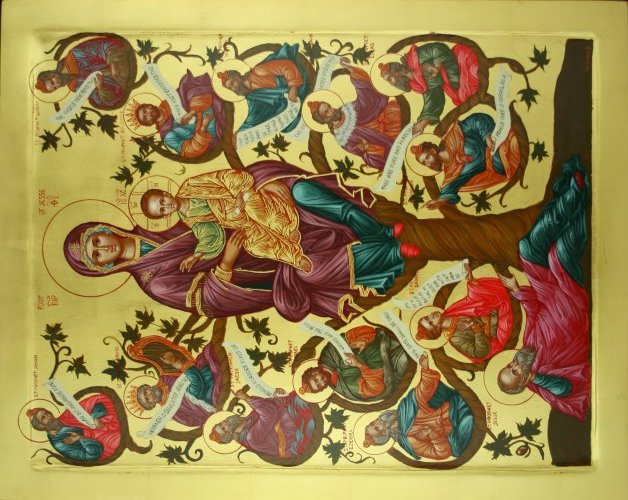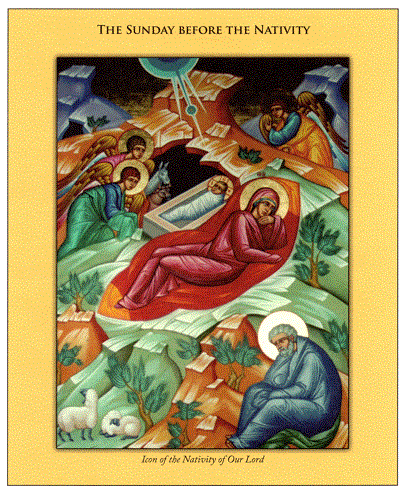PASTORAL MESSAGE OF THE UKRAINIAN CATHOLIC HIERARCHY OF THE U.S.A.
TO OUR CLERGY, HIEROMONKS AND BROTHERS, RELIGIOUS SISTERS,
SEMINARIANS AND BELOVED FAITHFUL
CHRIST IS BORN!
 “Glory to God in the highest, and peace [to men of good will/to those on whom His favor rests].” (Luke 2: 14)
“Glory to God in the highest, and peace [to men of good will/to those on whom His favor rests].” (Luke 2: 14)
Our preparations for the great feast of the Nativity of Our Lord, God, and Savior Jesus Christ bring to mind the song of the angels at Bethlehem. It is good for us to meditate upon them during this season, and perhaps even to let this meditation influence our New Year’s resolution as we prepare also for the arrival of 2015. It is especially important to remember the angelic promise of peace this year since there seems to be so little peace these days: we need to be reminded that, despite the headlines which scream of “man’s inhumanity to man”, God’s plan for us is different from the one inflicted upon the world by leaders whose cold, calculating ambition and insatiable greed know no bounds, thugs for whom people are merely tools to be used and discarded, for whom life is of no value.
The ancient song was first heard in a world which, although separated from us by two millennia and by a wide technological chasm, was really not so different in terms of human nature. What was that world? Saint Paul tells the Galatians “When the fullness of time had come, God sent His Son, born of a woman, born under the law, to ransom those under the law, so that we might receive adoption. (4: 4-5)” Does this mean that everything was perfect? Far from it! Some romantics like to point out that Jesus was born during what was referred to as the Pax Romana – that is, the “Roman Peace”. Outwardly, it may have looked as though peace reigned throughout the Roman world, but that peace was only maintained by Roman state-sponsored terror tactics – tactics like the crucifixion to which Jesus would eventually be sentenced since he was considered a threat to that very same Pax Romana. Not to be outdone by the cruelty of the Romans, the petty monarch Herod resorted to infanticide when faced with the same newborn threat to his power, ordering the murder of every male child under the age of two. Such was the Pax Romana; it is no wonder that the people seethed under the conqueror’s boot! The Romans and their puppets had reason to fear rebellion.
So what about “the fullness of time”? A possible answer can be found in any of the twelve-step programs such as Alcoholics Anonymous. According to the twelve-step paradigm, people with addictions are often not ready to change their lives until they have “hit bottom” – in other words, until their life has gotten so bad that there is no way to go but up. Perhaps this was the realization which was dawning on the people at that time. Can’t you hear them moaning as they pray to God for relief in the words of Psalm 123?
To you I raise my eyes,
to you enthroned in heaven.
Yes, like the eyes of servants
on the hand of their masters,
Like the eyes of a maid
on the hand of her mistress,
So our eyes are on the Lord our God,
till we are shown favor.
Show us favor, Lord, show us favor,
for we have our fill of contempt.
Our souls are more than sated
with mockery from the insolent,
with contempt from the arrogant.
It is to such people, seeking to be ransomed from the violence and disorder of their world, that the angels sang of peace.
Nothing much has changed in two thousand years: if anything, our technology has made us more effective at inflicting murder and mayhem. Nonetheless, we dare bravely to join our voices in the angels’ song, stubbornly refusing to give up on the promise of peace. As we do so, we must remember that peace is not a gift which, like the snow, comes down from heaven to refresh the earth and hide the scars we have inflicted. Rather, it is our task, our vocation. As Pope Paul VI reminds us, “If you want peace, work for justice.” The prophet Isaiah (2: 3-5; 11: 6-9) provides just such a glorious vision of people striving together for the peace which God intends for the world, and then enjoying the fruits of their labors:
Many peoples shall come and say:
“Come, let us go up to the Lord’s mountain,
to the house of the God of Jacob,
That he may instruct us in his ways,
and we may walk in his paths.”
For from Zion shall go forth instruction,
and the word of the Lord from Jerusalem.
He shall judge between the nations,
and set terms for many peoples.
They shall beat their swords into plowshares
and their spears into pruning hooks;
One nation shall not raise the sword against another,
nor shall they train for war again.
House of Jacob, come,
let us walk in the light of the Lord!
…
Then the wolf shall be a guest of the lamb,
and the leopard shall lie down with the young goat;
The calf and the young lion shall browse together,
with a little child to guide them.
The cow and the bear shall graze,
together their young shall lie down;
the lion shall eat hay like the ox.
The baby shall play by the viper’s den,
and the child lay his hand on the adder’s lair.
They shall not harm or destroy on all my holy mountain;
for the earth shall be filled with knowledge of the Lord,
as water covers the sea.
“With a little child to Guide them” – ah, yes, the newborn Prince of Peace. May His peace be with all of us, and with our world, in this holy season and throughout the year to come.
+Stefan Soroka
Archbishop of Philadelphia for Ukrainians
Metropolitan of Ukrainian Catholics in the United States
+Richard Seminack (author)
Eparch of St. Nicholas in Chicago
+Paul Chomnycky, OSBM
Eparch of Stamford
+ Bohdan Danylo
Eparch of St. Josaphat in Parma
+John Bura
Auxiliary Bishop of Philadelphia
Christmas 2014
 Thus the crowd greeted the Messiah by waving palm branches and joyfully crying Hosanna to him as he entered Jerusalem. The expression Hosanna to the Son of David was an exhortation to acclaim or praise the Messiah in hopes of deliverance probably from the hated Romans in the mind of the crowd.
Thus the crowd greeted the Messiah by waving palm branches and joyfully crying Hosanna to him as he entered Jerusalem. The expression Hosanna to the Son of David was an exhortation to acclaim or praise the Messiah in hopes of deliverance probably from the hated Romans in the mind of the crowd.



